Hot potted plants for hot summer days
During the lazy days of summer, the last thing I feel like doing is standing for an hour with the hose in my hand while the Death Star beats down on me or mosquitoes suck me dry. So I skip right over all those magazine stories about making colorful potted arrangements of leafy tropicals or thirsty annuals and put water-thrifty succulents, cactus, and the occasional grassy groundcover in all my garden containers. As a bonus, they look good all year and don’t require switching out plants with the seasons. Here’s an old chip-and-dip set my mother gave me that’s now an easy-care succulent dish, accented with chunks of turquoise slag glass and glass beads. I’ve got a blue theme going here…
…but here’s a serendipitous color match with the salmon-colored rim of the container and the sunset colors of a small Agave leopoldii. Some succulents respond to the stress of drought or heat with a change of color. I assume that’s what this one is doing. It gets absolutely baked on the sunny deck during long summer days, and I often forget to water it.
I think it’s pretty this way.
Succulents like echeveria and sedum require a lot more shade in our climate. I grow them only in dappled shade or a little morning sun.
I’m growing an entire wall of them in my cinderblock planter wall. (Click for a how-to on constructing a cinderblock planter wall of your own.)
Another view. Cardinals have been nipping off the fleshy leaves of some of my succulents. I guess they find them tasty—like a juicy watermelon?
Echeveria in bloom
Its companions on the back steps are equally tough, although the purple oxalis does require watering at least twice a week.
These are tougher bad boys, requiring water in summer only once every week or two: Dyckia, a misshapen ball cactus, golden barrel cactus, and ‘Royal Spine’ agave.
You can go on vacation for a while and they’ll be fine. I like that.
Sadly, my fairly new ‘Royal Spine’ agave has some off-coloring that is not due to drought or heat. I suspect some type of sucking insect damage and need to treat it. Anyone ever seen this problem before?
‘Bloodspot’ mangave
Well, they’re mostly trouble-free.
All material © 2006-2012 by Pam Penick for Digging. Unauthorized reproduction prohibited.


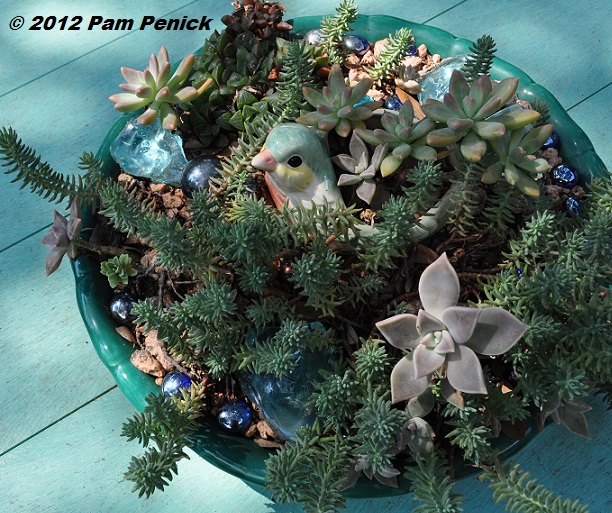
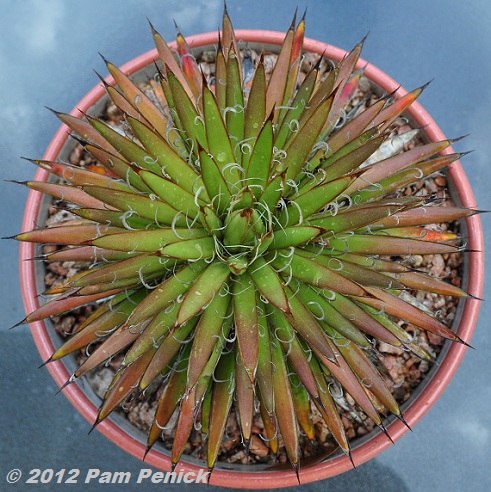
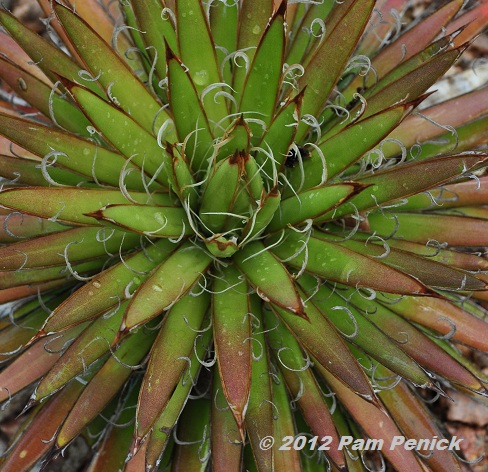
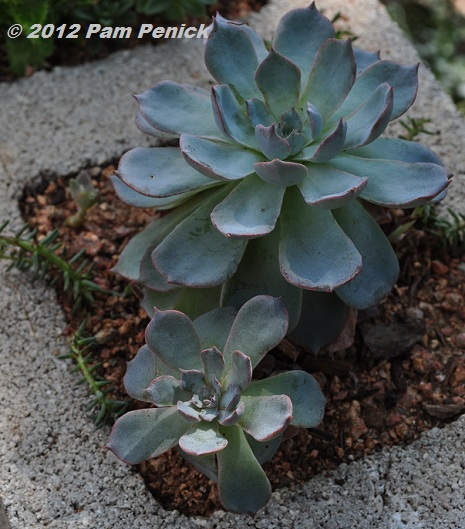
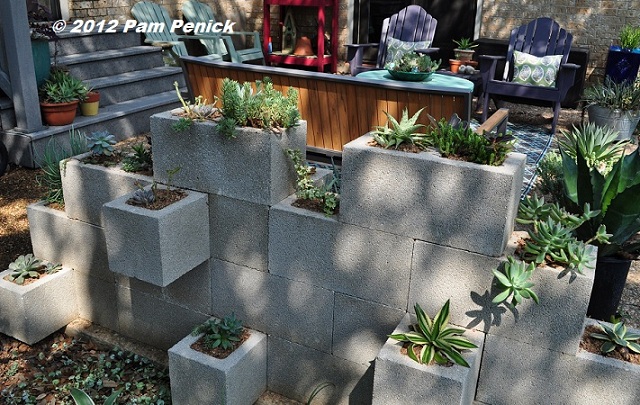
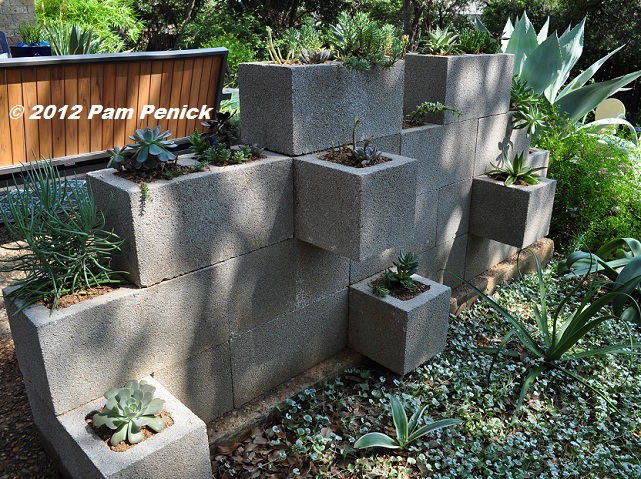
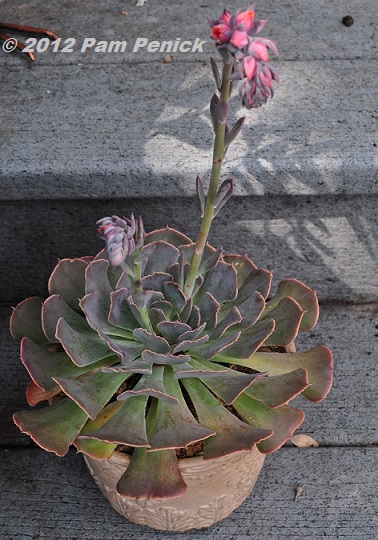
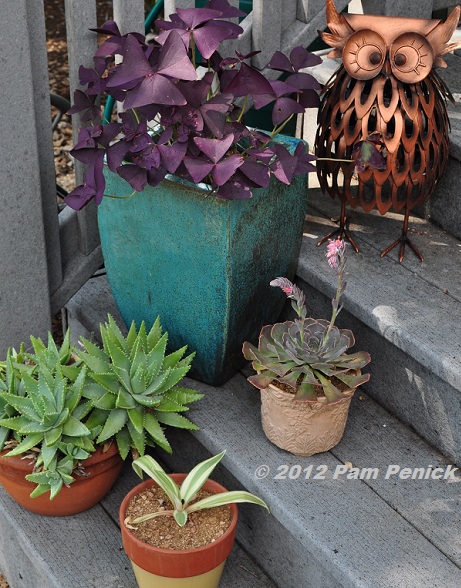
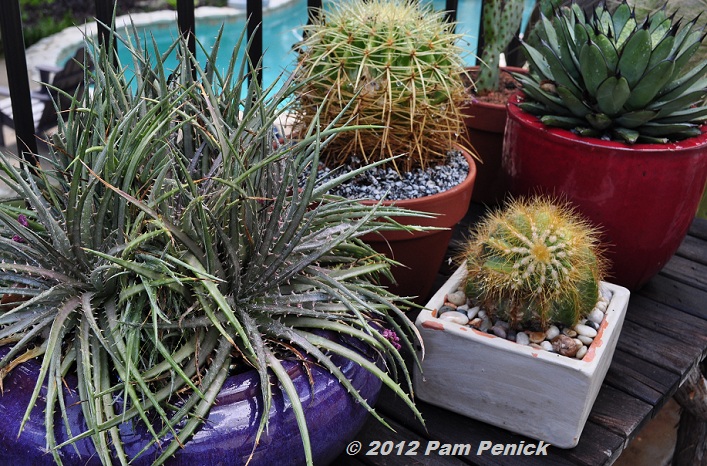
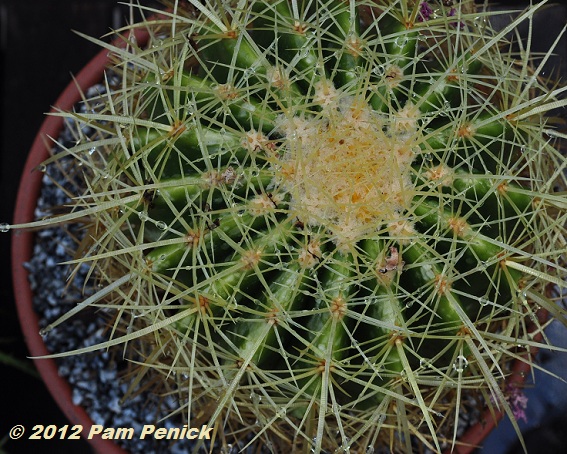
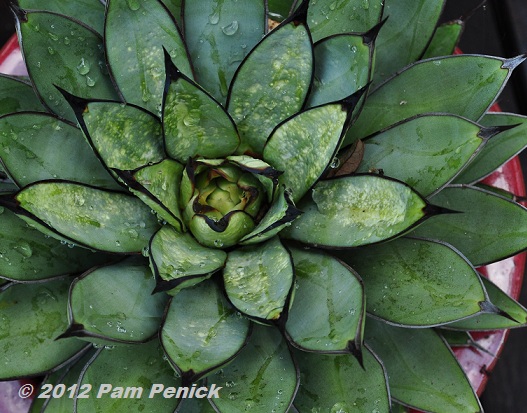
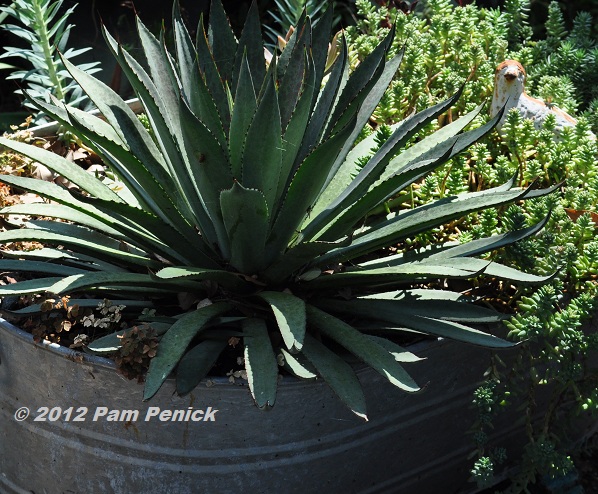
Funny…when I bought my purple oxalis, I was warned not to overwater it, but then our conditions are so different than yours. I’m inspired by the cinder block wall: it’s been a while since we have gotten a glimpse of it.
Too funny! Yes, you get a lot more miraculous water from the sky than we do, Ricki—or at least it’s delivered in a more useable form than Texas’s all-or-nothing gully-washers. —Pam
Man, I’m so glad you said sedums need dappled sun. I’ve tried growing them multiple times after much instance from the person I was buying them from that they were GREAT in full sun. Then they crisped up and died.
Nice to hear I should look for somewhere a bit more protected. Maybe I’ll start them under a mature prickly pear.
Hi, Tim. They really prefer bright shade in our climate (central Texas). A little morning sun is OK, but afternoon sun will shrivel them up. Sharp-draining soil in a container is best. I haven’t had much luck with them in the ground. —Pam
Great post. I need to explore succulents more…are many of them hardy up here in zone 7 do you think? Can you recommend a book?
Some sedums, sempervivums, and ice plant should work for you, Mary. And yuccas, of course. Check out Hardy Succulents and Succulent Container Gardens for inspiration. Or just think of them as beautiful, carefree annuals that deliver a lot of bang for the buck. —Pam
Oh, and I love your cinder block planter!
Thanks, Mary. It’s been a fun addition to the patio garden. —Pam
Pam,
When you’re ready to transplant that pot of Dyckia, tell me. I’ll start praying for your safety.
I’ve seen it done and recollect that it was like watching someone stick their hand into an alligator’s mouth.
Nice collection of pots and their happy residents!
David/:0)
You’re telling me, David! I dug out a dyckia-gone-wild from another, larger planter yesterday, and my hands have the cuts to prove it. Or maybe they’re from the razor-sharp edges of a squid agave, which I also transplanted. Oy! —Pam
Stay safe under that Death Star. Some here (challenged LA’s) actually use spray-irrigated sedums on their green roofs—here. Your plant and design choices work much better – tough plants that can take it. The mix of different shaped pots with assorted small succulents is great, and that’s a good use of too small of pots. I agree that coloration on the agave you note may be stress; some cacti do that.
I’ve confess that I’ve barely used smaller succulents – so far. To date, I haven’t gone wrong with Hesperaloe parviflora, Nolina, Echinocereus, Portulaca, etc.
Of course I love larger succulents too, especially of the agave and yucca variety. The small-succulent roof seems crazy, though, in your desert climate. I remember that picture of a prickly pear roof—now THAT makes more sense. —Pam
Love the cinder block wall! And the reddish agave that seems to be matching its pot! I don’t grow many succulents as they don’t quite fit in with my garden theme, but I have one birdhouse with a succulent roof. I love it – I never water it (or pretty much anything in the front gardens for that matter) and it’s fine. After our big heat wave, some of them had shriveled up, but as soon as we got rain (thankfully) they plumped back up.
That is so interesting that the cardinals eat some of those plants. I guess they get some liquid that way.
What a charming birdhouse that must be! I love that idea, Indie. —Pam
You know I am lovin this post Pam! Your cinderblock planter still rocks! Such a great idea! Wish I had more room. That leopoldii is so beautiful and you put it in the perfect pot! Keep on inspiring!
Thanks, Candy! I shall try. (It’s pretty easy, actually. There’s inspiration to be found everywhere.) —Pam
They look great Pam. I’m still experimenting with such plants and finding varying levels of success. I really love Agaves but have few varieties to try in Zone 6.
Hmm, yes, there aren’t as many for your zone. You can always keep small ones in pots and protect them in the winter. I bring in or cover a number of my potted plants, even though I’m two zones warmer than you. Of course, most of the winter they can be left outdoors, since we generally get only a few freezes. —Pam
I love your cinder block planter wall. Such a great way to create separate spaces and display display some plants.
Thanks, Ruth. I love it for those reasons too. And because it was just plain fun to make. —Pam
I have a wonderful pot of echeveria going. It lives in quite a bit of shade and does well. I haven’t had cardinals munching on them yet. My cardinals probably haven’t seen them enough to know they are tasty treats. I just love the variety of succulents you can grow outside. Mine all have to brought inside during winter so they have to be able to tolerate low light. Those are few and far between it seems.
Many of the succulents I grow are not hardy here either, Lisa, if we were to get a hard freeze or several nights of below-freezing. But they’ll take occasional frosts, especially if I cover them up with a sheet. I keep them up by the house in the winter, and an evergreen live oak provides additional protection, so I usually only have to protect them a handful of times during the winter. Or I just treat the small succulents as annuals and replace them in spring. —Pam
Wonderful arrangements, Pam. I’m a succulent and sedum addict. The birds – both cardinals and mocking birds – are my biggest problem. Wish they’d stick to the seed, suet and fresh water and leave my pots alone! I have started covering some of the pots with wire cloches; otherwise, they’d be destroyed.
That’s a good solution, Sandy. Isn’t it odd how it’s just those two species of birds that nip at them? It’s the same in my garden. —Pam
Pam,my “Royal Spine” agave has the same issue that yours is showing. I don’t have a clue as to the cause, and other plants in the same area are fine. Thanks so much for your posts!
I consulted a local agave expert, Janet, and he thinks it’s insect damage. He wrote, “There is a little bug that causes damage like that to agaves and more often yuccas. They move around fairly quickly and like to hide where you can’t see them. I’m not sure if insecticidal soap will kill them or not. I know there are several insecticides that will.” —Pam
Great planters you have there! Is it just me or does that agave “royal spine” look like it is about to flower? as for the marks, looks like hail damage?
Hi, Branden. The marks do resemble hail damage—they’re rough to the touch, and pocked—but we’ve had no hail since I bought it. Only the new leaves are affected. I think it’s insect damage, and an agave expert I consulted agrees (see my answer to the comment above yours). I think I need to treat it. —Pam
Wow, great idea! I think I’m going to do more of that next summer. I especially like the part about being able to go on vacation and not worry about them. 😉
It’s nice to have worry-free plants when you leave town. —Pam